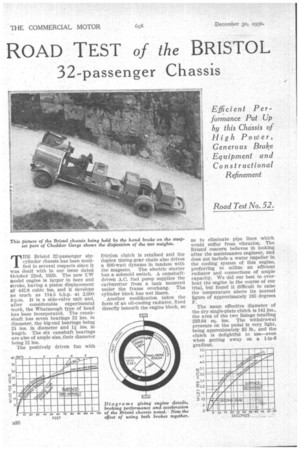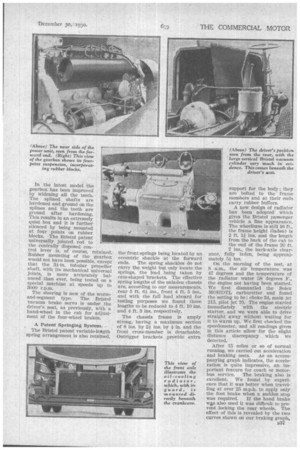ROAD TEST of the BRISTOL
Page 50

Page 51

Page 52

If you've noticed an error in this article please click here to report it so we can fix it.
32-passenger Chassis
Efficient Performance Put Up by this Chassis of High Power, Generous Brake Equipment and Constructional Refinement
THE Bristol 32-passenger sixcylinder chassis has been modified in several respects since it was dealt with in our issue dated October 22nd, 1929. The new UW model engine is larger in bore and stroke, having a piston displacement of 442.8 cubic ins, and it develops as much as 114.5 b.h.p. at 2,600 r.p.m. It is a side-valve unit and, after considerable experimental work, the Whatniough type of head has been incorporated. The crankshaft has seven bearings 21 ins, in diameter, the big-end bearings being 21 ins, in diameter and 11 ins, in length. The six camshaft bearings are also of ample size, their diameter being 21 ins.
The positively driven fan with friction clutch is retained and the duplex timing-gear chain also drives a 600-watt dynamo in tandem with the magneto. The electric starter has a solenoid switch. A camshaftdriven A.O. fuel pump supplies the carburetter from a tank mounted under the frame overhang. The cylinder block has wet liners. '
Another modification takes the form of an oil-cooling radiator, fixed directly beneath the engine block, so as to eliminate pipe lines which would suffer from vibration. The Bristol concern believes in looking after the maintenance engineer, and does not include a water impeller in the cooling system of this engine, preferring to utilize an efficient radiator and connections of ample capacity. We did our best to overheat the engine in the course of our trial, but found it difficult to raise the temperature above its normal figure of approximately 185 degrees F.
The mean effective diameter of the dry single-plate clutch is 14i ins., the area of the two linings totalling 233_64 sq. ins. The withdrawal pressure on the pedal is very light, being approximately 35 lb., and the clutch is delightful to use—even when getting away on a 1-in-6 gradient. In the latest model the gearbox has been improved by widening all the teeth. The splined shafts are hardened and ground on the splines and the teeth are ground after hardening. This results in an extremely quiet box and it is further silenced by being mounted at four points on rubber blocks. The Bristol patent universally jointed rod to the centrally disposed control lever is, of course, retained. 'tubber mounting of the gearbox would not have been possible, except that the 3i-in. tubular propeller shaft, with its mechanical universal joints, is more accurately balanced than ever, being tested on a special machine at speeds up to 3000 r.p.m.
The steering is now of the wormand-segment type. The Bristol vacuum brake servo is under the driver's seat, as previously, with a hand-wheel in the cab for adjustment of the four-wheel brakes.
A Patent Springing System..
The Bristol patent variable-length spring arrangement is also retained, the front-springs being located by an eccentric shackle at the forward ends. The spring shackles do not carry the weight but only locate the springs, the load being taken by cam-shaped brackets. The effective spring lengths of the unladen chassis are, according to our measurements, rear 5 ft. fil ins., front 4 ft. 5 ins., and with the full load aboard for testing purposes we found these lengths to be reduced to 4 ft. 10 ins. and 4 ft. 3 ins. respectively.
The chassis frame is amply strong, having a maximum section of 8 ins. by 2i ins, by in. and the front cross-member is detachable. Outrigger brackets provide extra support for the body; they are bolted to the frame members and at their ends carry rubber buffers.
A new design of radiator has been adopted which gives the Bristol passenger vehicle a fine appearance. The wheelbase is still 10 ft., the frame height (laden) is 2 ft. 14 ins, and the length from the back of the cab to the end of the frame 20 ft. 7 ins., the back-axle clearance, fully laden, being approximately 5i ins.
On the morning of the test, at 8 a.m., the air temperature was 47 degrees and the temperature of the radiator water 58 degrees F., the engine not having been started. We first dismantled the Solex MOIIDTL carburetter and found the setting to be : choke 34, main jet 215, pilot jet 70. The engine started immediately with the electric starter, and we were able to drive straight away without waiting for it to warm up. We first checked the speedometer, and all readings given in this article allow for the slight distance discrepancy which we detected.
After 15 miles or so of normal running, we carried out acceleration and braking tests. As an accompanying graph indicates, the acceleration is quite impressive, an important feature for coach or motorbus service. The braking also is excellent. We found by experience that it was better when travelling at over 25 m.p.h. to apply only the foot brake when a sudden stop was required. If the hand brake wits also used it was difficult to prevent locking the rear wheels. The effect of this is revealed by the two curves shown on our braking graph, Lnd the extra power of the rear n*akes is provided by the makers lo as to be quite sure that a frontvheel skid shall not occur.
Brake Details and Performance.
The brake drums are large and :he friction area is exceptionally so, ,he result being that, with only the foot brake, one obtains retardation aqual to that of most modern vehicles employing both brakes together. The vacuum cylinder is ex tremely powerful, yet the action is smooth and progressive. When measuring braking distances it struck us as remarkable to think " that, should a child fall down in the road 140 ft. in front of a Bristol coach carrying 32 passengers and travelling at 40 m.p.h., the child would not be hurt.
During the day we tested theholding capacity of the brakes on gradients up to 1 in 6. Either brake would hold the 7+ tons on this gradient ; even with the servo inoperative (i.e., with engine stopped) it was just possible to hold the chassis with the foot brake.
Our first hill-climb was Bridge Valley Road, between Bristol and Bath. In the course of 0.6 mile the climb is 225 ft. and this was nego tiated on second gear in two minutes.
The average gradient is about 1 in 14 and our average speed was 18 m.p.h. The climb had no effect upon the cooling-water temperature. Later we climbed the hill leading up to Dundry village. This is 1.8 mile in length, the ascent being 450 ft. The early part of the climb was effected in third and fourth gears and the slowest speed, at a point where the gradient was about 1 in 12, was 13 m.p.h. on second gear. Our time was five minutes, the aver' age speed being 21.6 m.p.h.
We made two quick ascents of Cheddar Gorge which, with its turns, forms a useful test. Our slowest sneed on the gradient of about 1 in 6 was 8 m.p.h. on second gear, and we had power in hand to travel faster, but for the fear of meeting another vehicle. The ascent of 550 ft. (in 2.85 miles) was made in eight minutes, the average speed being 21.4 m.p.h.—an extremely good performance.
Amply satisfied as to hill-climbing ability, we proceeded to make three fuel-consumption tests, each on one gallon of spirit. In the first we covered 6.6 miles at an average speed of 26.4 m.p.h. In the second, in the course of which we once exceeded 50 m.p.h. and travelled as fast as the hilly, winding road would permit, averaging 30 m.p.h., we covered 4.95 miles, our altitude meter showing an ascent of 200 ft. In the third test, also on a give-andtake road, with a net descent of 160 ft., we covered 6.6 miles at 24.75 m.p.h. The average result was, therefore, 6.05 m.p.g., which we regard as quite satisfactory for a vehicle of this high power-weight ratio. For an " ordinary " stretch of English main road the consumption would be at the rate of about 6.4 m.p.g. on this carburetter setting. The company has other settings, higher and lower in the performanceeconomy scale.
Summing Up.
As regards our impressions after a day at the wheel, the only adverse point noted was that the steering seemed a trifle stiff. This, we are sure, was due to the extreme newness of the chassis (it had covered only 100 miles) and the fact that we had too much load on the front axle. The steering is positive and secure. Springing is very good and the chassis is as steady as a rock at any speed, being particularly comfortable on bumpy country lanes.
The transmission and gearbox are beautifully balanced and extremely silent.
The response to the throttle is most pleasing and, due, we believe, to the Whatinough head, it was found that the best results were obtained by keeping the ignition advanced almost to pinking point.
This Bristol chassis is one that incorporates ingenuity and sound practice in every factor of its design. The result is that it is easy and pleasurable to drive, comfortable from the passengers' point of view, creditably quiet, and straightforward from the maintenance aspect. The company's operating experience stands it in good stead.




























































































